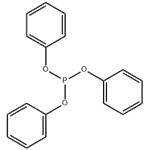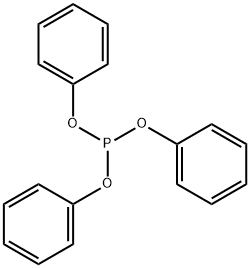Triphenyl Phosphite: A Comprehensive Overview
May 14,2024
Introduction
Triphenyl phosphite (TPhP) is a versatile chemical compound that serves as a critical element in various industrial and chemical processes. Known chemically as P(OC6H5)3, this organophosphorus compound has garnered attention for its role in stabilizing polymers and serving as a reactant in the synthesis of other phosphorus compounds. Its unique chemical structure offers high stability and reactivity, making it invaluable in the manufacture of plastics, rubber, and various specialty chemicals. Moreover, its effectiveness in polymer stabilization helps extend the life and enhance the performance of these materials, underscoring its importance in industrial applications[1].

Figure 1 Characteristics of Triphenyl phosphite
Synthesis of Triphenyl Phosphite
The synthesis of triphenyl phosphite typically involves the reaction of phenol with phosphorus trichloride. This process is conducted under controlled conditions where phenol reacts with phosphorus trichloride in the presence of a suitable base that neutralizes the hydrochloric acid formed during the reaction.
This reaction is not only efficient but also scalable, making it suitable for industrial production. Recent advances in synthesis methods have focused on improving yield and reducing by-products, which are crucial for environmental sustainability and economic efficiency.
Main Components
The primary component of triphenyl phosphite is the triphenyl phosphite molecule itself, consisting of three phenyl groups bound to a phosphorus atom through oxygen atoms. The molecular structure confers stability and reactivity, allowing it to interact with various substrates and radicals. The purity of TPhP is critical for its effectiveness, especially in applications requiring high precision such as in pharmaceuticals and fine chemicals. Its molecular arrangement enables unique electronic properties that facilitate its function as a ligand in coordination chemistry, enhancing the synthesis of metal complexes used in catalysis and materials science.
Applications of Triphenyl Phosphite
Triphenyl phosphite finds extensive use across several domains, predominantly as a stabilizer and antioxidant in the production of polymers and plastics. Its antioxidative properties help in preventing the degradation of polymers during high-temperature processing. Moreover, TPhP is utilized as a plasticizer in certain applications, enhancing the flexibility and durability of materials. Its role extends to acting as a flame retardant where it helps in reducing the flammability of materials, thereby increasing safety standards in consumer goods and automotive components.
In organic synthesis, triphenyl phosphite is employed as a reagent in the transformation of certain organic compounds. It acts as a reducing agent or a catalyst in various chemical reactions, playing a pivotal role in synthesizing complex molecules for pharmaceuticals and agrochemicals. Additionally, TPhP is instrumental in the synthesis of phosphite esters and phosphonates, which are crucial in producing crop protection chemicals and pharmaceutical intermediates. Its use in facilitating the Wittig reaction underscores its utility in creating complex organic compounds, particularly in the synthesis of vitamins and hormones. This wide range of applications not only highlights the chemical's versatility but also its critical importance in advancing chemical research and development.
Storage Methods
Proper storage of triphenyl phosphite is crucial to maintain its chemical integrity and ensure safety. TPhP should be stored in a cool, dry place away from direct sunlight and moisture. It is typically kept in tightly sealed containers made of materials that do not react with phosphite compounds, such as glass or certain plastics. Safety data sheets recommend handling triphenyl phosphite under inert atmospheres to prevent oxidation and hydrolysis, which can lead to degradation of the product and release of phosphoric acids.
Conclusion
Triphenyl phosphite plays an indispensable role in modern chemistry, with applications that span across various industries from manufacturing to pharmaceuticals. Its synthesis is a model of industrial chemical processes, combining efficiency with environmental considerations. As industries continue to evolve, the importance of TPhP as a stabilizer and chemical reactant is likely to grow, underscoring the need for continuous research and development in its applications and handling practices[2].
References
[1]Barnes D J, Chapman R L, Vagg R S, et al. Synthesis of novel bis (amides) utilizing triphenyl phosphite intermediates[J]. Journal of Chemical and Engineering Data, 1978, 23(4): 349-350.
[2]Baran J, Davydova N A, Drozd M. Polymorphism of triphenyl phosphite[J]. The Journal of Chemical Physics, 2014, 140(10).
- Related articles
- Related Qustion
- Triphenyl phosphite: synthesis, applications in organic synthesis and safety Dec 19, 2023
Triphenyl phosphite has versatile applications in organic synthesis as a reactant and catalyst but has potential safety hazards that require careful handling and safety protocols.
- Triphenyl phosphite: properties and applications Jul 12, 2023
Triphenyl phosphite plays a crucial role in organic synthesis, polymer preparation, and metal coordination chemistry, offering enhanced efficiency and selectivity in numerous chemical processes.
- Triphenyl phosphite- Biological Toxicity Feb 17, 2020
Triphenyl phosphite (TPP) is the chemical compound with the formula P(OC6H5)3. This colourless viscous liquid is the ester of phosphorous acid and phenol.
Malic acid is used to increase food acidity, giving more flavor, but it is also used as a flavoring substance and color stabilizer. It is identified with the acronym E296.....
May 13,2024Food AdditivesPyrroloquinoline quinone is a fascinating molecule with a broad spectrum of applications in health, agriculture, and technology.....
May 14,2024APITriphenyl phosphite
101-02-0You may like
Triphenyl phosphite manufacturers
- Triphenyl Phosphate(TPP) CAS: 101-02-0
-

- $1.00 / 100G
- 2024-01-08
- CAS:101-02-0
- Min. Order: 100G
- Purity: 99.9%
- Supply Ability: 50000 tons
- Triphenyl phosphite
-

- $100.00 / 1KG
- 2023-12-24
- CAS:101-02-0
- Min. Order: 1KG
- Purity: 99%
- Supply Ability: g-kg-tons, free sample is available
- Triphenyl phosphite
-

- $10.00 / 1bottle
- 2023-09-14
- CAS:101-02-0
- Min. Order: 1bottle
- Purity: 99%
- Supply Ability: 100MT




